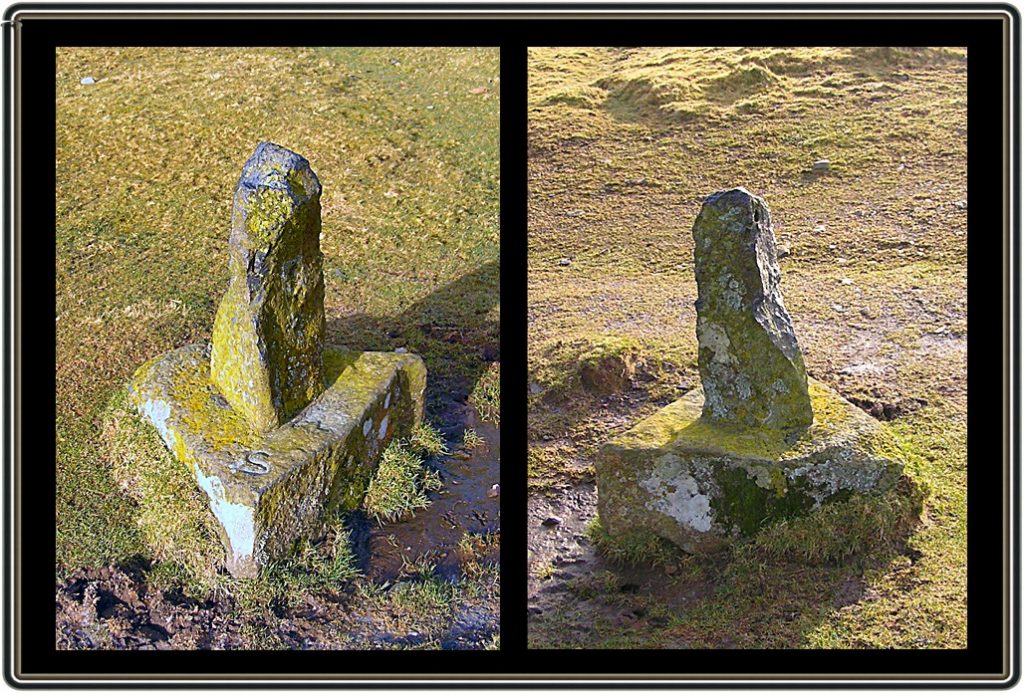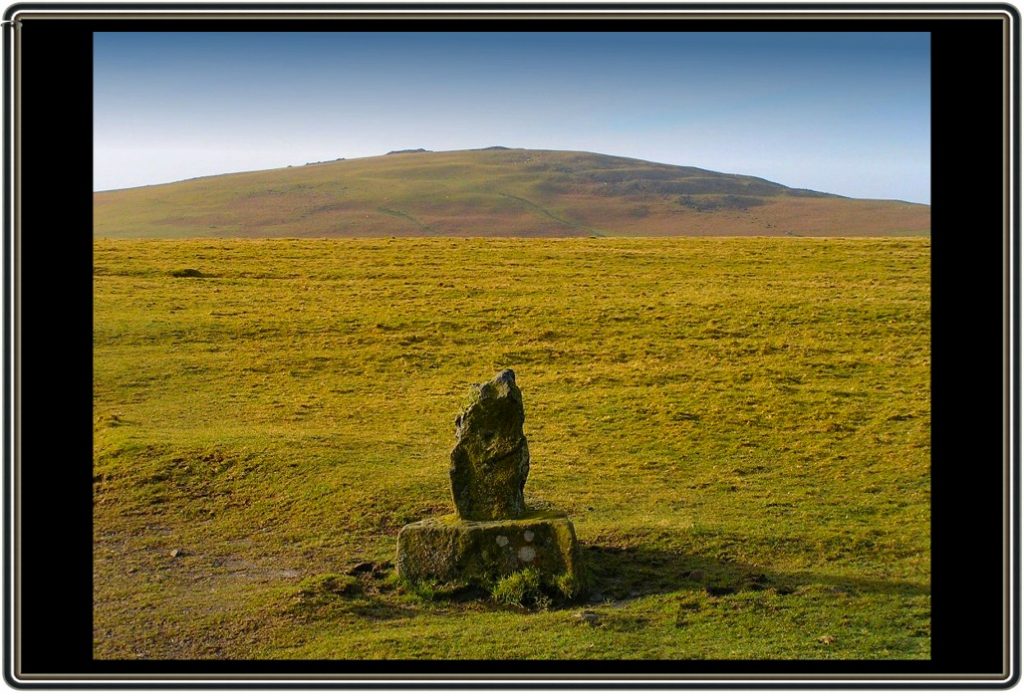
There are various accounts of the story of Stephen’s Grave and here is a brief synopsis and the conflicting versions. About three hundred years ago lived a man called George Stephens, the tale is that old that some say he was named John. Either way he lived at Peter Tavy on the edges of western Dartmoor. Here he met and fell madly in love with a local girl. Once more, depending on who you speak to, she either spurned his advances, fell in love with another lad or her parents rejected poor young George because he was deemed unworthy of their daughter. They all had the same result which was to break his heart, he became inconsolable and could only see one way out. Sadly, driven by his melancholy he took his own life. One version relates how he first killed the girl by giving her a poisoned apple and then after she had died ate the rest so their souls could walk together in the eternal land. Another account relates how he poisoned himself by eating deadly nightshade, other less specific reports simply say that he died from poisoning. There is very little known about this story. Mrs Bray goes to great lengths to relate the tale, calling the boy ‘George’. Crossing, 1990, p.152, suggests that there was a George Stephens living in Peter Tavy and that he was buried as a suicide on the moor. Hemery, 1983, pp. 956-7, is more forthcoming with his views when he notes that the lads name was “John Stephens whose death occurred in October 1762,” although where that information comes from he does not say.
However, a partial account of the events was written by members of the Bray family which ended up in the hands of Sabine Baring Gould which he published in the Transactions of the Devonshire Association in 1901, pp. 123 – 126. If this is to believed it sheds a lot more light on matters. The account stated that John Stephens lived with Roger Chubb at Godsworthy Farm. By all accounts he was a farm servant and a man of good character and appearance. Mary Bray lived with her parents, Andrew and Mary Bray at nearby Wedlake farm. Over time John and Mary began courting but it did not take long for Mary’s parents to express their deep approval of the relationship. and soon put a stop to it. As you can imagine John Stephens was inconsolable as he had become infatuated with Mary who he had hoped to marry. Shortly after the separation was the day of the Tavistock Michaelmas Fair to which John decided to visit. Unfortunately Mary and her parents had also gone to the fair where he spotted Mary in the company of another man. This proved too much for him and in a fit of despair and jealousy he went into a chemist and purchased some poison which he said he wanted to kill rats with. Having took the poison he then went to the house of Mr. Caunday who was a barber when he became unwell and began vomiting. Having been sick he felt somewhat better and so made his way home but on the way back he met the Bray family who were also returning to Wedlake. For some reason the party paid a visit to Radge where although he intended to Take some more of the poison he was unable to do so. After leaving Radge Stephens and the Brays continued their homeward journey as far as Yelland Corner where they parted company. At around ten o’ clock that night John arrived back at Godsworthy where he was once again taken ill and began violently vomiting. Mr. Chubb immediately rode off to summons the doctor but by the time they both returned John Stevens had died. The account described how the doctor found Stephens’ body swollen and discoloured that he had no hesitation diagnosing death by poisoning. Apparently by the next morning the stench from the corpse was so bad that the body was taken to what was described as; “a corner of a field and put it in a hole that was made for sheep to pass from one field to another and was called … Corner.” The actual corner name was not given but could possibly have been Lawns Corner at the southern end of the Godsworthy enclosures. Actually no it couldn’t, thinking logically there would be no sheep creep in an enclosure wal that abuts the open moor, they would all escape – doh!. It also can be assumed that the ‘hole which allowed sheep to pass through was a sheep creep. There the corpse lay until the inquest was held where a verdict of suicide was pronounced. It was also stated that the body was to be buried; “at the first four crossways near Broadmoor Corner. Today the marker stone of the grave can still be seen near to Broadmoor Corner. Shortly after his death the ghost of John Stephens was seen at both Godsworthy and Wedlake as well at various point along the tracks leading to these farms. The manifestations took the form of ‘yawsel’ (unusual) noises and various items rattling which completely unnerved the occupants. So much so the services of the Rev. Dr. Jago of Tavistock were called upon who it appeared managed to lay John’s soul to rest. Unfortunately the person who wrote this account was not very literate and parts of it are hard to decipher but the ending was as follows; “but he appeared to the said Mary Bray hafter she left her Fathers howse and went to service in so much she received and injury as A Woman Pregnant or as one looking for a child and had A wound to the day of her Death that she would not make known how she got it nor what she had seen but would not deny but she had seen something.” Make of that what you will. Mary was never married and lived until the 3rd of May 1816 when on that day she died in a chair at her brother’s house, aged 72.
As was the way of things all suicides could not be buried in hallow ground and so like Kitty Jay, George Stephen’s was buried at a bleak, windswept crossroads on the edge of the moors. It was said that at the very moment he was lowered into his peaty grave, a white sheet that was hanging on a nearby washing line was blown into the sky; Up into the air it gently wafted and was never seen again. As noted above, it was soon reported that his ghost could be seen in the locality of his grave on dark nights. Many local people would not venture out after dark to cross the moor for fear of seeing his tormented spirit.
As can be seen from the photograph above, there certainly is a stone marking something. Hemery, p.957, notes that in May 1936, the Dartmoor Preservation Association set the stone pillar on a more secure plinth. There is the letter ‘S’ engraved on the pillar. It actually stands beside the Peter Tavy track thus giving credence to the wayside burial of suicides.

Crossing, W. 1990 Crossing’s Guide to Dartmoor, Peninsula Press, Newton Abbot.
Hemery, E. 1983 High Dartmoor, Hale, London.
S. B. Gould. 1901. Stephen’s Grave – Transactions of the Devonshire Association, Vol. XXXIII.
 Legendary Dartmoor The many aspects past and present of Dartmoor
Legendary Dartmoor The many aspects past and present of Dartmoor




Interesting tale Tim, worthy of a painting! I must take a look at the location around Peter Tavy, it’s an area of the moor I have neglected. DF
Great site and interesting details. You might want to check the location of Peter Tavy though. “Either way he lived at Peter Tavy on the edges of eastern Dartmoor.”. Last time I was there it was on the western edge!
Thanks for pointing this out – duly amended.